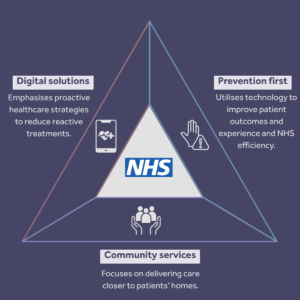
Over the next two decades, the UK’s population is predicted to grow by 7.3% (Office for National Statistics) and by 2040 one in seven people will be aged over 75 (Government Office for Science). More people are living with multiple long-term conditions requiring care, increasing demand on NHS resources. The health service must evolve and harness innovation to meet these challenges and deliver high-quality cost-effective care. Health Innovation Networks are pivotal to making it happen.
We have a proven track record built up over more than a decade in supporting innovators and the NHS, achieving rapid and widespread adoption of innovative solutions.
In this blog I highlight examples where we’re working with the NHS and innovators to realise the government’s three strategic shifts in healthcare. Your innovation could be one of the future solutions the NHS needs.
The three shifts reshaping NHS healthcare
1. Prevention first
Innovation will be a vital component in moving from reactive treatment to proactive prevention.
- Diagnostics: Digital tools to identify and prioritise high-risk individuals sooner.
Example: An AI-enabled diagnostic tool helps clinicians spot respiratory conditions earlier, so patients get the right care faster. We conducted a feasibility study and engaged with key stakeholders in the NHS chronic obstructive pulmonary disease (COPD) diagnostic pathway to assess the clinical need, perceived potential benefits, acceptability and barriers to adoption of the device.
2. Strengthening primary and community services
Moving care closer to home where it’s safe and clinically appropriate to do so.
- Remote monitoring & ‘hospital at home’: Keeping people at home, reducing unnecessary admissions and getting patients back home more quickly.
Example: A ‘hospital at home’ model reduced pressure on hospitals and improved patient flow. We led an evaluation, working closely with NHS partners to measure outcomes and identify opportunities for wider adoption.
3. Harnessing digital solutions
Digital-first solutions to improve efficiency, enhance patient experience and free up NHS staff to focus on care.
- AI and automation: Reducing time spent on repetitive tasks so healthcare professionals can dedicate more time to patients.
Example: An automated voice system powered by AI is supporting routine clinical conversations with thousands of calls already made to patients following cataract surgery, freeing up hundreds of hours of clinicians’ time for face-to-face appointments with the patients who need them.
- Integrating digital/AI into patient pathways to support clinical decision-making.
Example: New image analysis technology enables high quality CT brain scans to be shared quickly and securely using imaging software incorporating AI, helping non-specialists to rapidly identify and refer stroke patients who require thrombectomy, improving access to this life-changing treatment.
Ready to bring your innovation to the NHS?
If you are an innovator and have a solution which addresses one of these challenges, the NHS needs you. Solutions that support decision-making, improve productivity or streamline team coordination are crucial. Health Innovation Oxford and Thames Valley and other Health Innovation Networks can help you navigate the system and connect with key stakeholders. We help innovators shape their offer, access the right partners, and accelerate adoption. With more than a decade of experience, we know how to get innovations into real-world use.
Get in touch to explore opportunities

